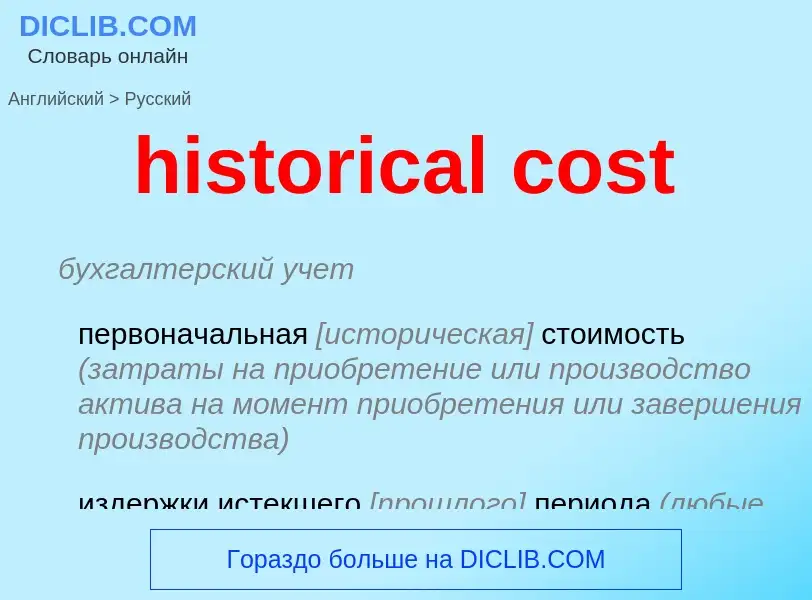Vertaling en analyse van woorden door kunstmatige intelligentie
Op deze pagina kunt u een gedetailleerde analyse krijgen van een woord of zin, geproduceerd met behulp van de beste kunstmatige intelligentietechnologie tot nu toe:
- hoe het woord wordt gebruikt
- gebruiksfrequentie
- het wordt vaker gebruikt in mondelinge of schriftelijke toespraken
- opties voor woordvertaling
- Gebruiksvoorbeelden (meerdere zinnen met vertaling)
- etymologie
historical cost - vertaling naar Engels
бухгалтерский учет
первоначальная [историческая] стоимость (затраты на приобретение или производство актива на момент приобретения или завершения производства)
издержки истекшего [прошлого] периода (любые расходы организации, понесенные в прошлых отчетных периодах)
синоним
Смотрите также
2) pl фактические издержки в определённом истекшем периоде
бухгалтерский учет
учет по себестоимости [первоначальной стоимости] (бухгалтерский учет в фиксированных ценах или ценах приобретения актива (по фиксированным курсам, ставкам); оценка инвестиций по ценам на момент осуществления, а не по текущим ценам)
синоним
Смотрите также
Definitie
Wikipedia

In accounting, an economic item's historical cost is the original nominal monetary value of that item. Historical cost accounting involves reporting assets and liabilities at their historical costs, which are not updated for changes in the items' values. Consequently, the amounts reported for these balance sheet items often differ from their current economic or market values.
While use of historical cost measurement is criticised for its lack of timely reporting of value changes, it remains in use in most accounting systems during periods of low and high inflation and deflation. During hyperinflation, International Financial Reporting Standards (IFRS) require financial capital maintenance in units of constant purchasing power in terms of the monthly CPI as set out in IAS 29, Financial Reporting in Hyperinflationary Economies. Various adjustments to historical cost are used, many of which require the use of management judgment and may be difficult to verify. The trend in most accounting standards is towards more timely reflection of the fair or market value of some assets and liabilities, although the historical cost principle remains in use. Many accounting standards require disclosure of current values for certain assets and liabilities in the footnotes to the financial statements instead of reporting them on the balance sheet.
For some types of assets with readily available market values, standards require that the carrying value of an asset (or liability) be updated to the market price or some other estimate of value that approximates current value (fair value, also fair market value). Accounting standards vary as to how the resultant change in value of an asset or liability is recorded; it may be included in income or as a direct change to shareholders' equity.
The capital maintenance in units of constant purchasing power model is an International Accounting Standards Board approved alternative basic accounting model to the traditional historical cost accounting model.


